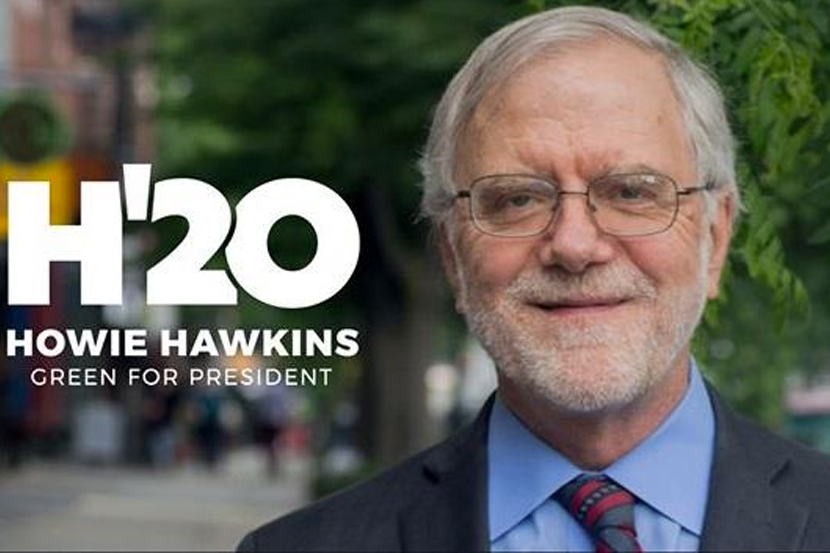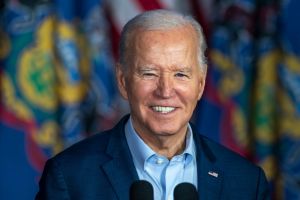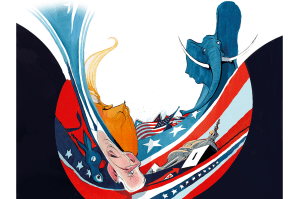Within the last year, election officials and judges in a few key swing states reduced the Green party’s erstwhile ballot access to write-in only. They likely intended to reduce the Greens’ vote share to the benefit of Joe Biden and the Democratic party.Voters in Arizona, Pennsylvania and Wisconsin might have noticed the unusual absence of the Green party’s presidential ticket from their 2020 ballots. Democrat-controlled courts and Democratic election officials denied Green presidential candidate Howie Hawkins and his VP pick Angela Walker a place on those states’ ballots. ‘We believe Howie and Angela were removed from the ballot in those states by officials acting on partisan motivations,’ Green party communications manager Michael O’Neil told The Spectator.In 2016, Green candidate Jill Stein received 34,345 votes in Arizona, 51,463 in Michigan, 49,941 in Pennsylvania, and 31,072 votes in Wisconsin. If most of those votes had gone instead to Hillary Clinton, she would have won the latter three and the presidency. This possibility was not lost on the many Democrats who blamed Stein for Hillary’s otherwise inconceivable loss in those states.If Stein’s 2016 vote totals were subtracted from Biden’s in 2020, his current leads in Wisconsin and Pennsylvania would evaporate. The already-tightening race in Arizona would be much closer. Of course, it would be speculative to assume that the Greens’ presence on ballots would have done Trump any favors. Just look at Michigan, where Biden still eked out a plurality despite Hawkins’s place on ballots statewide. Greens’ enthusiasm also seems lower this cycle, perhaps after a divisive nominating process that alienated would-be supporters. The present national leadership of the party has proven quite controversial and disenchanting. Compared to other putative candidates, such as Jesse Ventura, Hawkins lacks mainstream appeal and recognition. ‘Green leaders don’t want to win,’ the host of PRIMO NUTMEG, a dissident left podcast, told The Spectator. ‘They want money. The rest is all a show.’ As of Friday evening, Hawkins has only received 343,308 votes nationally, well short of the 1,457,218 that Stein won. What remains clear is a pattern of the deliberate suppression of the Green party to minimize its threat to the Democrats’ monopoly on left-of-center voters. Partisan election officials have a clear motive as well as the means — the simple ability to restrict ballot access.‘The infamous Boss Tweed of Tammany Hall always said “you can vote however you want, as long as I get to pick the candidates.”,’ O’Neil told The Spectator.Voting along party lines, Wisconsin’s electoral commission rejected the Greens’ slate in August 2020. Their rationale was a significant clerical error in the nominating papers for Hawkins’s running mate, Angela Walker. In September, the Wisconsin Supreme Court’s liberal members joined with a sole conservative member to deliver a 4-3 verdict against the Green party’s inclusion on the state’s absentee and in-person ballots.Within a week of the Wisconsin court’s decision, the Pennsylvania Supreme Court ordered that the Greens be taken off the state’s ballots over a modest error. The Associated Press reports that the Greens had faxed in a nominating affidavit due on August 3, but were not told until August 25 that the fax format was unacceptable. While the two Republican justices argued that the Greens should get an opportunity to fix the terror, the court’s five Democratic justices held that the Greens’ failure to hand in an original affidavit on time was an irreversible and fatal mistake.In Arizona, the Democrats’ role in the Greens’ exclusion is less obvious than in the other two. The Arizona Green party lost official recognition and ballot access in December 2019 after a weak performance in the 2018 gubernatorial race. The state’s Republican-controlled legislature also reduced the amount of time that third parties had to collect signatures for nominating petitions. The Greens were ultimately unable to meet the signature requirement to stay on the ballot. Though the Arizona Democrats certainly benefited from the Greens’ loss of recognition, the Arizona Republic says that it may have been a Republican plan to squeeze out the Libertarian party that resulted in the Greens’ exclusion from the final ballot.‘Ballot access questions are adjudicated by election boards and judges with partisan loyalties or even outright affiliation, meaning we have left the two parties in charge of regulating their own elections,’ O’Neil said. ‘That makes for a mockery of democracy.’Notably, the Libertarian party, usually thought to siphon voters away from the Republican party, had ballot access in all 50 states.Democrats’ particular antipathy towards the Green party has lingered since the 2000 election. Ralph Nader, a public safety champion and environmental activist, won 97,488 votes in Florida as the Green party. Only 538 of his votes in Florida could have shifted the state to Al Gore’s column. So, Democrats have long tarred Nader and his party as spoilers who cost them the presidency and ushered in eight years of Bushite dominion. Under closer examination, however, the Democrats’ narrative about Nader’s spoiler effect doesn’t hold up. Approximately 308,000 self-identified Democrats voted for Bush, while only 24,000 voted for Nader.
[special_offer]
Nevertheless, Democratic hostility to the Green party has extended to other swing states, such as Nevada.The Green party hasn’t been on the ballot in Nevada since the 2012 election. During the run-up to the 2012 election, Nevada looked like a swing state. After all, it had gone for Bush in both 2000 and 2004. In 2000, Ralph Nader won just over 15,000 votes in Nevada, which would not have been enough for Al Gore to win. Though he won the state handily in 2008, Obama held only a narrow lead over Romney, according to pre-election polls in 2012. In 2016, an Obama-appointed federal judge rejected the Green’s attempt to get back on the Nevada ballot, leading to accusations of ‘foul play.’ So, the Democratic have had a vendetta to destroy, de-platform and disempower the Green party in key swing states. Depending on the conclusions of the ongoing counts, recounts, lawsuits and recrimination, their suppression efforts may have won them the election in states they lost in 2016.


















